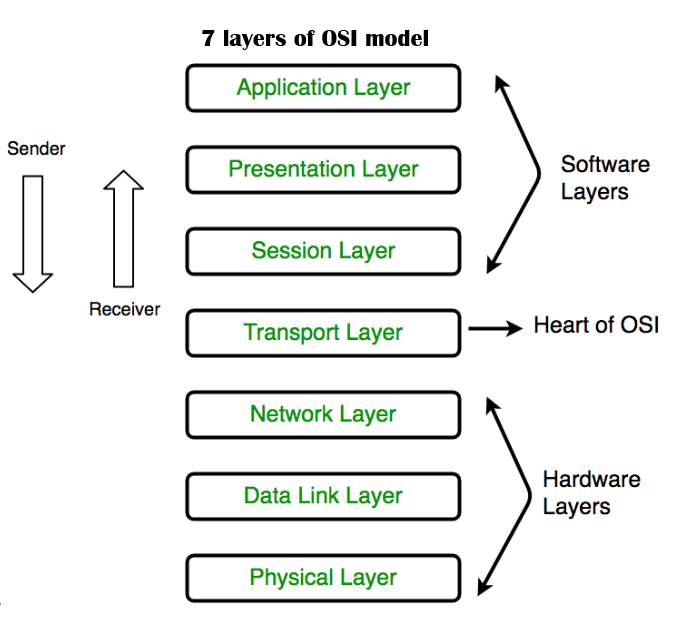Physical Layer in the OSI Model: Functions, component and Protocols
In an OSI (Open Systems Intercommunication) model, the physical layer (Layer 1) is the lowest or bottom most layers of OSI model, which standardizes the functions of a telecommunication or computing system. The primary responsibility of the Physical Layer is to transmit raw bitstreams coming from upper layer (Data link layer) over a physical medium. Physical layer establishes, maintains and deactivates the physical connection.
Learn more about OSI model Click here
Table of Contents
Data rate also maintained by the function of the Physical Layer. It defines how two or more devices are connected to a link by line configuration. Physical layer also maintain the Synchronization between sender and receiver. This layer also provide functionality to its upper layer called Data Link Layer (DLL). Physical layer pick data from data link layer and encode it at the sender side and decode data at the receiver side.
Physical Layer in the OSI Model: Its Functions
Physical Layer in the OSI Model
Functions of the Physical Layer
The key responsibility of physical layer is sending bits from one node to another node along the network. Its role is determining how physical connections to the network are set up, as well as how bits are represented into signals — as they are transmitted either in the form of electrical signal, optical signal or by radio waves.
To do all this, the physical layer performs a different functions, that are given below:
- Bit Transmission: The Physical Layer is responsible for transmitting raw bits (0s and 1s) from one node to another over a physical medium, such as cables, fiber optics, or radio waves.
- Signal Encoding: It converts the data bits into signals that can be transmitted over the physical medium. This include encoding bits into electrical, optical, or radio signals depending on the medium used.
- Data Rate Control: It determines the rate at which data is transmitted over a physical medium, which is usually measured in bits per second (bps). This data rate can vary depending on the transmission medium and the technologies used.
- Topologies: It defines how two or more devices physically and logically connect to make a network. There are six types of topologies such as bus topology, star topology, ring topology, and mesh topology, tree topology and hybrid topologies.
5. Transmission Modes: It describes the direction of the data flow. Transmission modes are classified into three types: Simplex, Half-Duplex, and Full-Duplex.
6. Interfaces and Standards: The Physical Layer defines the hardware specifications and interfaces, including pin layouts, voltage levels, cable types, connectors, and other physical attributes. Examples include RS-232, RJ45, and V.35.
7. Multiplexing: Multiplexing is the process of combining multiple data streams and send it through a single stream for transmission over a communication channel. It uses different methods like Frequency Division Multiplexing (FDM) or Time Division Multiplexing (TDM) to allow multiple signals to share the same physical medium. Multiplexing is done at the sender side and demultiplexing is done at receiver side.
Components of the Physical Layer
- Cables and Connectors: Physical layer use physical media such as twisted pair cables, coaxial cables, optical fiber cables, and wireless media (radio waves, microwaves).
- Network Interface Cards (NICs): It is a hardware device that connects a computer to a network.
- Repeaters and Hubs: These are the devices that is use to extend the range of a network by amplifying the signals.
- Modems: It is a devices that modulate and demodulate signals for transmission over telephone lines or cable systems.
Physical layer Standards and Protocols
- Ethernet (IEEE 802.3): It specifies the physical and data link layer’s operation in wired Ethernet networks.
- Wi-Fi (IEEE 802.11 ): It governs wireless networking.
- Optical Transport Network (ITU-T G.709): it defines the standard for optical fiber networks.
- SONET/SDH: It is a standards for synchronous optical networking.
youtube link
Examples of physical layer technologies
- Ethernet: The most widely used LAN technology that operates at both the data link and physical layers. Uses various media like twisted pair (Cat5e, Cat6) and fiber optics.
- Fiber Optics: It uses light signals for high-speed data transmission over long distances with minimal loss.
- DSL (Digital Subscriber Line): It uses existing telephone lines to provide high-speed internet access.
- Wi-Fi: Wireless technology that provides high-speed internet and network connections.
What is the Physical Layer in the OSI Model?
The Physical Layer is the first and lowest layer of the OSI (Open Systems Interconnection) model. It is responsible for the transmission and reception of raw bit streams over a physical medium, such as cables, optical fibers, or radio waves.
What are the main functions of the Physical Layer?
1. Bit Transmission: Transmits raw bits from one device to another.
2. Signal Encoding: Converts bits into signals suitable for the transmission medium.
3. Data Rate Control: Manages the speed at which data is transmitted.
4. Physical Topologies: Defines the physical layout of network devices.
5. Transmission Modes: Supports simplex, half-duplex, and full-duplex modes.
6. Synchronization: Ensures sender and receiver are synchronized.
7. Multiplexing: Allows multiple signals to share the same medium.
8. Physical Interfaces and Standards: Specifies hardware details like pin layouts and voltage levels.
What are some common physical media used in the Physical Layer?
1. Twisted Pair Cables: Commonly used for Ethernet connections.
2. Coaxial Cables: Used for cable TV and internet.
3. Fiber Optic Cables: Provides high-speed data transmission over long distances.
4. Radio Waves: Used for wireless communications like Wi-Fi and Bluetooth.
What are some devices associated with the Physical Layer?
1. Network Interface Cards (NICs): Connect computers to networks.
2. Repeaters: Amplify signals to extend the range of a network.
3. Hubs: Basic devices that connect multiple Ethernet devices.
4Modems: Modulate and demodulate signals for transmission over telephone lines or cable systems.
